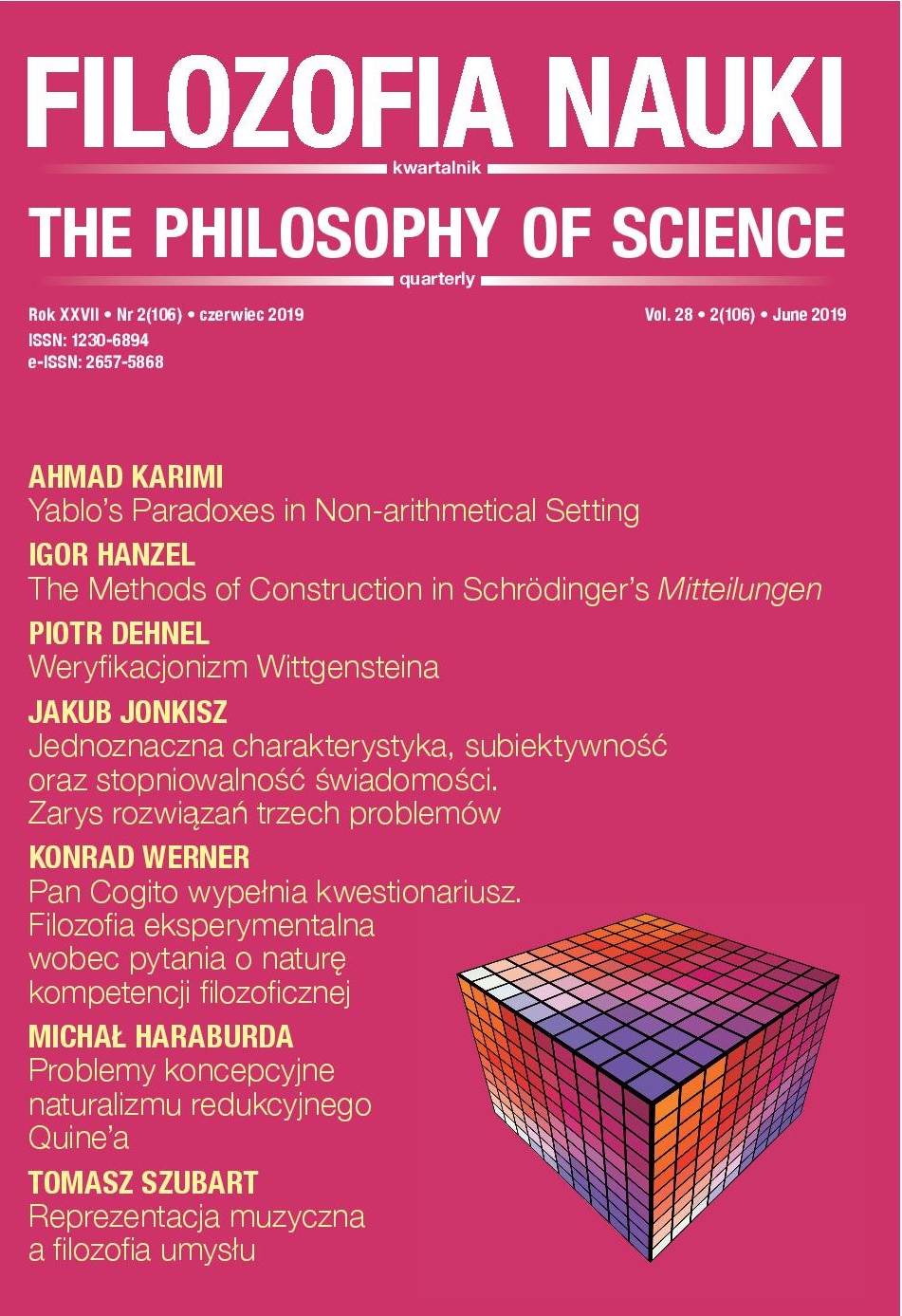Jednoznaczna charakterystyka, subiektywność oraz stopniowalność świadomości. Zarys rozwiązań trzech problemów
DOI:
https://doi.org/10.14394/filnau.2019.0011Słowa kluczowe:
pojęcie świadomości, świadomość stopniowalna, wymiary świadomości, subiektywność, świadomość subiektywnaAbstrakt
Contemporary consciousness studies are a field that presents us with a multiplicity of more or less fundamental empirical and theoretical problems. Of these, the most basic concerns the lack of an unambiguous characterization of consciousness itself. There is no universal description of the phenomenon in question, or at least no widely accepted definition, while most working applications of the concept in articles, research projects or empirical trials vary significantly. A closely linked question concerns the relationship between consciousness and subjectivity: are the conscious states of an organism or system coextensive with its subjective states? Such an assumption, though by no means self-evidently valid, seems to be operative in many influential conceptions and theories of consciousness today. Yet another important issue within the current debate concerns the question of whether consciousness is a graded or an all-or-none phenomenon. This problem is particularly interesting because some researchers insist that it is very difficult to justify ascribing such gradedness to consciousness given its manifold dimensions. The aim of this article is to present and justify these solutions in a condensed form, while at the same time pointing out their consequences and related issues worthy of further study.
Bibliografia
Armstrong D. M. (1979), Three Types of Consciousness, „Ciba Foundation Symposium” 69, 235-253.
Baars B. (1994), A Thoroughly Empirical Approach to Consciousness, „Psyche" 1(6), 1-18.
Baars B. (1996), Understanding Subjectivity: Global Workspace Theory and the Resurrection of the Observing Self, „Journal of Consciousness Studies” 3(3), 211-216.
Baars B. (2002), The Conscious Access Hypothesis: Origins and Eecent Evidence, „Trends in Cognitive Sciences” 6(1), 47-52. https://doi.org/10.1016/S1364-6613(00)01819-2
Baars B. (2012), The Biological Cost of Consciousness, „Nature Proceedings”. https://doi.org/10.1038/npre.2012.6775.1
Baars B., Franklin S., Ramsoy T. Z. (2013), Global Workspace Dynamics: Cortical “Binding and Propagation” Enables Conscious Contents, „Frontiers in Psychology” 4, 200. https://doi.org/10.3389/fpsyg.2013.00200
Ballestar E. (2010), Epigenetics Lessons from Twins: Prospects for Autoimmune Disease, „Clinical Reviews in Allergy & Immunology” 39(1), 30-41. https://doi.org/10.1007/s12016-009-8168-4
Bandettini P. A. (2009), What’s New in Neuroimaging Methods?, „Annals of the New York Academy of Sciences” 1156, 260-293. https://doi.org/10.1111/j.1749-6632.2009. 04420.x
Barrett A. B., Seth A. K. (2011), Practical Measures of Integrated Information for TimeSeries Data, „PLoS Computational Biology” 7(1). https://doi.org/10.1371/journal.pcbi.1001052
Bayne T. (2009), Consciousness [w:] The Routledge Companion to Philosophy of Psychology, J. Symons, P. Calvo (eds.), New York, NY: Routledge, 477-494.
Bayne T., Hohwy J., Owen A. M. (2016), Are There Levels of Consciousness?, „Trends in Cognitive Science”, 20(6), 405-413. https://doi.org/10.1016/j.tics.2016.03.009
Bisenius S., Trapp S., Neumann J., Schroeter M. L. (2015), Identifying Neural Correlates of Visual Consciousness with ALE Meta-analyses, „Neuroimage” 122, 177-187. https://doi.org/10.1016/j.neuroimage.2015.07.070
Block N. (1995), On Confusion about a Function of Consciousness, „Behavioral and Brain Sciences” 18(2) 227-287. https://doi.org/10.1017/S0140525X00038188
Bossdorf O., Richards C. L., Pigliucci M. (2008), Epigenetics for Ecologists, „Ecology Letters” 11(2), 106-115. https://doi.org/10.1111/j.1461-0248.2007.01130.x
Brook A. (2008), Terminology in Consciousness Studies, http://www.ym.edu.tw/assc12/tutorials.html#02
Carruthers P. (1998), Animal Subjectivity, „Psyche” 4(3). http://journalpsyche.org/files/0xaa52.pdf
Carruthers P. (2018), Comparative Psychology without Consciousness, „Consciousness and Cognition” 63, 47-60. https://doi.org/10.1016/j.concog.2018.06.012
Carruthers P., (2016), Higher-Order Theories of Consciousness [w:] The Stanford Encyclopedia of Philosophy (Fall 2016 Edition), E. N. Zalta (ed.), https://stanford.io/2WcaFcb
Casali A. G., Gosseries O., Rosanova M., Boly M., Sarasso S., Casali K.R., …, Massimini M. (2013), A Theoretically Based Index of Consciousness Independent of Sensory Processing and Behaviour, „Science Translational Medicine” 5(198), 198ra105. https://doi.org/10.1126/scitranslmed.3006294
Casarotto S., Comanducci A., Rosanova M., Sarasso S., Fecchio M., Napolitani M., …, Massimini M. (2016), Stratification of Unresponsive Patients by an Independently Validated Index of Brain Complexity, „Annals of Neurology” 80(5), 718-729. https://doi.org/10.1002/ana.24779
Chalmers D. (1995), Facing up to the Problem of Consciousness, „Journal of Consciousness Studies” 2(3), 200-219.
Chalmers D. (1996), The Conscious Mind: In Search of a Fundamental Theory, Oxford: Oxford University Press.
Clowes R., Torrance S., Chrisley R. (2007), Machine Consciousness: Embodiment and Imagination, „Journal of Consciousness Studies” 14(7), 7-14.
Cohen M. A., Dennett D. C. (2011), Consciousness Cannot be Separated from Function, „Trends in Cognitive Science” 15(8), 358-364. https://doi.org/10.1016/j.tics.2011.06.008
Crane T. (2000), The Origins of Qualia [w:] The History of the Mind-Body Problem, T. Crane, S. Patterson (ed.), London: Routledge, 169-194.
Crick F., Koch C. (2003), A Framework for Consciousness, „Nature Neuroscience” 6(2), 119-126. https://doi.org/10.1038/nn0203-119
Damasio A. (1999), The Feeling of What Happens: Body, Emotion and the Making of Consciousness, London: Vintage.
Dehaene S., Kerszberg M., Changeux J.-P. (1998), A Neuronal Model of a Global Workspace in Effortful Cognitive Tasks, „Proceedings of the National Academy of Sciences of the United States of America” 95(24), 14529-14534. https://doi.org/10.1073/pnas.95.24.14529
Dehaene S., Naccache L. (2001), Towards a Cognitive Neuroscience of Consciousness: Basic Evidence and a Workspace Framework, „Cognition” 79(1-2), 1-37. https://doi.org/10.1016/S0010-0277(00)00123-2
Dehaene S., Changeux J.-P. (2011), Experimental and Theoretical Approaches to Conscious Processing, „Neuron” 70(2), 200-227. https://doi.org/10.1016/j.neuron.2011.03.018
Dehaene S., Lau H., Kouider S. (2017), What is Consciousness, and Could Machines Have It?, „Science” 358(6362), 486-492. https://doi.org/10.1126/science.aan8871
Dennett D. C. (1988), Quining Qualia [w:] Consciousness in Contemporary Science, A. Marcel, E. Bisiach (eds), Oxford: Oxford University Press, 42-77. https://doi.org/10.1093/acprof:oso/9780198522379.003.0003
Earl B. (2014), The Biological Function of Consciousness, „Frontiers in Psychology” 5, 697. https://doi.org/10.3389/fpsyg.2014.00697
Edelman G. (2003), Naturalizing Consciousness: A Theoretical Framework, „Proceedings of the National Academy of Sciences” 100(9), 5520-5524. https://doi.org/10.1073/pnas.0931349100
Edelman G., Tononi G. (2000), Re-entry and the Dynamic Core: Neural Correlates of Conscious Experience [w:] Neural Correlates of Consciousness, T. Metzinger (ed.), Cambridge, MA: MIT Press, 139-151.
Edelman D., Seth A. (2009), Animal Consciousness: A Synthetic Approach, „Trends in Neuroscience” 32(9), 476-484. https://doi.org/10.1016/j.tins.2009.05.008
Edelman G., Gally J. A., Baars B. (2011), Biology of Consciousness, „Frontiers in Psychology” 2, 4. https://doi.org/10.3389/fpsyg.2011.00004
Feinberg T. E., Mallatt J. (2013), The Evolutionary and Genetic Origins of Consciousness in the Cambrian Period over 500 Million Years Ago, „Frontiers in Psychology” 4, 667. https://doi.org/10.3389/fpsyg.2013.00667
Feinberg T. E., Mallatt J. (2016), The Nature of Primary Consciousness: A New Synthesis, „Consciousness and Cognition” 43, 113-127. https://doi.org/10.1016/j.concog.2016. 05.009
Fleming S. M., Weil R. S., Nagy Z., Dolan R. J., Rees G. (2010), Relating Introspective Accuracy to Individual Differences in Brain Structure, „Science” 329(5998), 1541-1543. https://doi.org/10.1126/science.1191883
Fleming S. M., Lau H. C. (2014), How to Measure Metacognition, „Frontiers in Human Neuroscience” 8, 443. https://doi.org/10.3389/fnhum.2014.00443
Fraga M. (2005), Epigenetic Differences Arise During the Lifetime of Monozygotic Twins, „Proceedings of the National Academy of Sciences” 102(30), 10604-10609. https://doi.org/10.1073/pnas.0500398102
Freund J., Brandmaier A. M., Lewejohann L., Kirste I., Kritzler M., Krüger A., …, Kempermann G. (2013), Emergence of Individuality in Genetically Identical Mice, „Science” 340(6133), 756-759. https://doi.org/10.1126/science.1235294
Frith C. D. (2011), What Brain Plasticity Reveals about the Nature of Consciousness: Commentary, „Frontiers in Psychology” 2, 87. https://doi.org/10.3389/fpsyg.2011. 00087
Gennaro R. (2005), The HOT Theory of Consciousness: Between a Rock and a Hard Place, „Journal of Consciousness Studies” 12(2), 3-21.
Giacino J. T. (2005), The Minimally Conscious State: Defining the Borders of Consciousness, „Progress in Brain Research” 150, 381-395. https://doi.org/10.1016/S0079-6123(05)50027-X
Griffin D. R. (2001), Animal Minds: Beyond Cognition to Consciousness, Chicago, IL: University of Chicago Press.
Hassin R. R. (2013), Yes It Can: On the Functional Abilities of the Human Unconscious, „Perspectives on Psychological Science” 8(2), 195-207. https://doi.org/10.1177/1745691612460684
Heavey C. L., Hurlburt R. T. (2008), The Phenomena of Inner Experience, „Consciousness and Cognition” 17(3), 798-810. https://doi.org/10.1016/j.concog.2007.12.006
Hesselmann G., Moors P. (2015), Definitely Maybe: Can Unconscious Processes Perform the Same Functions as Conscious Processes?, „Frontiers in Psychology” 6, 584. https://doi.org/10.3389/fpsyg.2015.00584
Hohwy J. (2009), The Neural Correlates of Consciousness: New Experimental Approaches Needed?, „Consciousness and Cognition” 18(2), 428-438. https://doi.org/10.1016/j.concog.2009.02.006
Hollande O. (ed.) (2003), Machine Consciousness, „Journal of Consciousness Studies” 10(4-5).
Jackson F. (1982), Epiphenomenal Qualia, „Philosophical Quarterly” 32(127), 127-136. https://doi.org/10.2307/2960077
Jonkisz J. (2009a), Wąskie, szerokie i rozszerzone rozumienie subiektywności w zagadnieniu świadomości, „Studia Philosophiae Christianae” 2, 191-211.
Jonkisz J. (2009b), Świadomość i subiektywność — razem czy osobno, „Analiza i Egzystencja” 9, 121-143.
Jonkisz J. (2012a), Pojęcie świadomości w nauce i filozofii umysłu — próba systematyzacji, „Filozofia Nauki” 20(2) [78], 29-57.
Jonkisz J. (2012b), Consciousness: A Four-Fold Taxonomy, „Journal of Consciousness Studies" 19(11-12), 55-82.
Jonkisz J. (2015), Consciousness: Individuated Information in Action, „Frontiers in Psychology” 6, 1035, https://doi.org/10.3389/fpsyg.2015.01035
Jonkisz J. (2016a), Subjectivity: A Case of Biological Individuation and an Adaptive Response to Informational Overflow, „Frontiers in Psychology” 7, 1206. https://doi.org/10.3389/fpsyg.2016.01206
Jonkisz J. (2016b), Świadomość jako zindywidualizowana informacja w działaniu. Uniwersalna charakterystyka, „Filozofia Nauki” 24(2) [94], 95-117.
Jonkisz J., Wierzchoń M., Binder M. (2017), Four-Dimensional Graded Consciousness, „Frontiers in Psychology” 8, 420. https://doi.org/10.3389/fpsyg.2017.00420
Kiefer M. (2012), Executive Control over Unconscious Cognition: Attentional Sensitization of Unconscious Information Processing, „Frontiers in Human Neuroscience” 6, 61. https://doi.org/10.3389/fnhum.2012.00061
Koch C., Tononi G. (2013), Reply to Searle, „The New York Review of Books” 3, available at: Can a photodiode be conscious?, http://www.nybooks.com/articles/archives/2013/mar/07/can-photodiode-be-conscious/
Koch C., Massimini M., Boly M., Tononi G. (2016), Neural Correlates of Consciousness: Progress and Problems, „Nature Reviews Neuroscience” 17(5), 307-321. https://doi.org/10.1038/nrn.2016.22
Kriegel U. (2006), Consciousness: Phenomenal Consciousness, Access Consciousness, and Scientific Practice [in:] Handbook of Philosophy of Psychology and Cognitive Science, P. Thagard (ed.), Amsterdam: North-Holland, 195-217.
Kriegel U. (2007), The Same-Order Monitoring Theory of Consciousness, „Synthesis Philosophica” 22(2), 361-384.
Lamme V. A. (2006), Towards a True Neural Stance on Consciousness, „Trends in Cognitive Sciences” 10(11), 494-501. https://doi.org/10.1016/j.tics.2006.09.001
Lau H., Rosenthal D. (2011), Empirical Support for Higher-Order Theories of Conscious Awareness, „Trends in Cognitive Sciences” 15(8), 365-373. https://doi.org/10.1016/j.tics.2011.05.009
Laureys S., Pellas F., Van Eeckhout P., Ghorbel S., Schnakers C., Perrin F., …, Goldman S. (2005), The Locked-in Syndrome: What Is It Like to be Conscious but Paralyzed and Voiceless? „Progress in Brain Research” 150, 495-511, https://doi.org/10.1016/S0079-6123(05)50034-7
Legrand D. (2007), Subjectivity and the Body: Introducing Basic Forms of Self-Consciousness, „Consciousness and Cognition” 16(3), 577-582. https://doi.org/10.1016/j.concog.2007.06.011
Levine J. (1983), Materialism and Qualia: The Explanatory Gap, „Pacific Philosophical Quarterly” 64, 354-361. https://doi.org/10.1111/j.1468-0114.1983.tb00207.x
Levine J. (2001), Purple Haze: The Puzzle of Consciousness, Oxford–New York: Oxford University Press.
Lindahl B. I. B. (1997), Consciousness and Biological Evolution, „Journal of Theoretical Biology” 187(4), 613-629. https://doi.org/10.1006/jtbi.1996.0394
Lycan W. G. (1996), Consciousness and Experience, Cambridge, MA: MIT Press.
Marti S., Kumar K. H., Castellani C. A., O’Reilly R., Singh S.M. (2011), Ontogenetic de Novo Copy Number Variations (CNVs) as a Source of Genetic Individuality: Studies on Two Families with MZD Twins for Schizophrenia, „PloS One” 6(3). https://doi.org/10.1371/journal.pone.0017125
Merker B. (2005), The Liabilities of Mobility: A Selection Pressure for the Transition to Consciousness in Animal Evolution, „Consciousness and Cognition” 14(1), 89-114. https://doi.org/10.1016/S1053-8100(03)00002-3
Metzinger T. (ed.) (2000), Neural Correlates of Consciousness: Empirical and Conceptual Questions, Cambridge, MA: The MIT PressA Bradford Book.
Migicovsky Z., Kovalchuk I. (2011), Epigenetic Memory in Mammals, „Frontiers in Genetics” 2(28). https://doi.org/10.3389/fgene.2011.00028
Morsella M. (2005), The Function of Phenomenal States: Supramodular Interaction Theory, „Psychological Review” 112(4): 1000-1021. https://doi.org/10.1037/0033-295X.112.4.1000
Morin A. (2006), Levels of Consciousness and Self-Awareness, „Consciousness and Cognition” 15(2), 358-371. https://doi.org/10.1016/j.concog.2005.09.006
Mudrik L., Breska A., Lamy D., Deouell L.Y. (2011), Integration without Awareness: Expanding the Limits of Unconscious Processing, „Psychological Science” 22(6). https://doi.org/10.1177/0956797611408736
Mudrik L., Faivre N., Koch C. (2014), Information Integration without Awareness, „Trends in Cognitive Science” 18(9), 488-496. https://doi.org/10.1016/j.tics.2014.04.009
Nagel T. (1974), What is It Like to be a Bat?, „Philosophical Review” 83, 435-451.
Neisser U. (2006), Unconscious Subjectivity, „Psyche” 12. http://journalpsyche.org/files/0xaaf7.pdf
Neisser U. (2015), The Science of Subjectivity, London: Macmillian. https://doi.org/10.1057/9781137466624
Northoff G., Musholt K. (2006), How Can Searle Avoid Property Dualism? Epistemic-Ontological Inference and Autoepistemic Limitation, „Philosophical Psychology” 19(5), 1-17.
Noë A., Thompson E. (2004), Are There Neural Correlates of Consciousness? „Journal of Consciousness Studies” 11(1), 3-28.
Overgaard M. (ed.) (2015), Behavioural Methods in Consciousness Research, Oxford: Oxford University Press. https://doi.org/10.1093/acprof:oso/9780199688890.001.0001
Overgaard M., Sandberg K. (2012), Kinds of Access: Different Methods for Report Reveal Different Kinds of Metacognitive Access, „Philosophical Transactions of the Royal Society B” 367(1594), 1287-1296. https://doi.org/10.1098/rstb.2011.0425
Overgaard M., Rote J., Mouridsen K., Ramsoy T. Z. (2006), Is Conscious Perception Gradual or Dichotomous? A Comparison of Report Methodologies during a Visual Task, „Consciousness and Cognition” 15(4), 700-708. https://doi.org/10.1016/j.concog.2006. 04.002
Overgaard M., Timmermans B., Sandberg K., Cleeremans A. (2010), Optimizing Subjective Measures of Consciousness, „Consciousness and Cognition” 19(2), 682-684. https://doi.org/10.1016/j.concog.2009.12.018
Palmer T. D., Ramsey A. K. (2012), The Function of Consciousness in Multisensory Integration, „Cognition” 125(3), 353-364. https://doi.org/10.1016/j.cognition.2012.08.003
Pally R. (2005), Non-conscious Prediction and a Role for Consciousness in Correcting Prediction Errors, „Cortex” 41(5), 643-662.
Pareira A., Ricke H. (2009), What is Consciousness? Towards a Preliminary Definition, „Journal of Consciousness Studies” 16(5), 28-45.
Pfefferbaum A., Sullivan E. V., Carmelli D. (2004), Morphological Changes in Aging Brain Structures are Differentially Affected by Time-Linked Environmental Influences Despite Strong Genetic Stability, „Neurobiology of Aging” 25(2), 175-183. https://doi.org/10.1016/S0197-4580(03)00045-9
Pfeifer R., Iida F., Lungarella M. (2014), Cognition from the bottom up: On Biological Inspiration, Body Morphology, and Soft Materials, „Trends in Cognitive Science” 18(8), 404-413. https://doi.org/10.1016/j.tics.2014.04.004
Pierre J. (2003), Intentionality [w:] Stanford Encyclopedia of Philosophy (Spring 2019 Edition), E. N. Zalta (ed.), 9. https://stanford.io/2wBe6i1
Pigliucci M. (2013), The Demarcation Problem. A (Belated) Response to Laudan [w:] Philosophy of Pseudoscience: Reconsidering the Demarcation Problem, M. Pigliucci, M. Boudry (eds.), Chicago: University of Chicago Press, https://doi.org/10.7208/chicago/9780226051826.003.0002
Rochat P. (2011), The Self as Phenotype, „Consciousness and Cognition” 20(1), 109-119. https://doi.org/10.1016/j.concog.2010.09.012
Rosenthal D. (1986), Two Concepts of Consciousness, „Philosophical Studies” 49, 329-359.
Sahraie A., Hibbard P. B., Trevethan C. T., Ritchie K. L., Weiskrantz L. (2010), Consciousness of the First Order in Blindsight, „PNAS”. https://doi.org/10.1073/pnas.1015652107
Sanborn A. N., Chater N. (2016), Bayesian Brains without Probabilities, „Trends in Cognitive Sciences” 20(12), 883-893. https://doi.org/10.1016/j.tics.2016.10.003
Schnakers C., Majerus S., Goldman S., Boly M., Van Eeckhout P., Gay S., …, Laureys S. (2008), Cognitive Function in the Locked-In Syndrome, „Journal of Neurology” 255(3), 323-330. https://doi.org/10.1007/s00415-008-0544-0
Searle J. (1992/1999), The Rediscovery of the Mind, Cambridge, MA: MIT Press. [Wydanie polskie: J. Searle, Umysł na nowo odkryty, tłum. T. Baszniak, Warszawa 1999].
Searle J. (2000), Consciousness, „Annual Review of Neuroscience” 23, 557-578. https://doi.org/10.1146/annurev.neuro.23.1.557
Sergent C., Dehaene S. (2004), Is Consciousness a Gradual Phenomenon? Evidence for an All-or-None Bifurcation during the Attentional Blink, „Psychological Science” 15(11), 720-728. https://doi.org/10.1111/j.0956-7976.2004.00748.x
Seth A. K. (2008), Causal Networks in Simulated Neural Systems, „Cognitive Neurodynamics” 2(1), 49-64. https://doi.org/10.1007/s11571-007-9031-z
Seth A. K. (2009), Functions of Consciousness [w:] Encyclopedia of Consciousness, W. P. Banks (ed.), Amsterdam: Elsevier/AcademicPress, 279-293.
Seth A. K., Baars B., Edelman D. (2005), Criteria for Consciousness in Humans and Other Mammals, „Consciousness and Cognition” 14(1), 119-139. https://doi.org/10.1016/j.concog.2004.08.006
Seth A. K., Friston K. J. (2016), Active Interoceptive Inference and the Emotional Brain, „Philosophical Transactions of the Royal Society B: Biological Sciences” 371. http://dx.doi.org/10.1098/rstb.2016.0007
Shimono M., Mano H., Niki K. (2012), The Brain Structural Hub of Interhemispheric Information Integration for Visual Motion Perception, „Cerebral Cortex” 22(2), 337-344. https://doi.org/10.1093/cercor/bhr108
Smith E., Delargy M. (2005), Locked-in Syndrome, „The BMJ” 330, 406. https://doi.org/10.1136/bmj.330.7488.406
Swaddle J. P., Cathey M. G., Cornell M., Hopkinton B. P. (2005), Socially Transmitted Mate Preferences in a Monogamous Bird: A Non-genetic Mechanism of Sexual Selection, „Proceedings of the Royal Society B: Biological Sciences” 272(1567), 1053-1058. https:// doi.org/10.1098/rspb.2005.3054
Teasdale G., Jennett B. (1974), Assessment of Coma and Impaired Consciousness. A Practical Scale, „Lancet II”, 81-86.
Theeuwes J. (2010), Top-down and bottom-up Control of Visual Selection, „Acta Psychologica (Amst)” 135(2), 77-99. https://doi.org/10.1016/j.actpsy.2010.02.006
Tononi G. (2004), An Information Integration Theory of Consciousness, „BMC Neuroscience” 5, 42. https://doi.org/10.1186/1471-2202-5-42
Tononi G. (2008), Consciousness as Integrated Information: A Provisional Manifesto, „The Biological Bulletin” 215(3), 216-242. https://doi.org/10.2307/25470707
Tononi G. (2010), Information Integration: Its Relevance to Brain Function and Consciousness, „Archives Italiennes de Biologie” 148(3), 299-322. https://doi.org/10.1098/rstb.2014.0167
Tononi G., Boly M., Massimini M., Koch C. (2016), Integrated Information Theory: From Consciousness to Its Physical Substrate, „Nature Reviews Neuroscience” 17(7), 450-461.
Tononi G., Koch C. (2014), Consciousness: Here, There but Not Everywhere, „Philosophical Transactions of the Royal Society B: Biological Sciences” 370, 1668. http://dx.doi.org/10.1098/rstb.2014.0167
Torrance S., Clowes R., Chrisley R. (eds.) (2007), Machine Consciousness: Embodiment and Imagination, „Journal of Consciousness Studies" 14(7) (numer specjalny).
Tsuchiya N., Wilke M., Frässle S., Lamme V. A. F. (2015), No-Report Paradigms: Extracting the True Neural Correlates of Consciousness, „Trends in Cognitive Sciences” 19(12), 757-770. https://doi.org/10.1016/j.tics.2015.10.002
van Gaal S., Lamme V. A. F. (2012), Unconscious High-Level Information Processing: Implication for Neurobiological Theories of Consciousness, „Neuroscientist” 18(3), 287-301. https://doi.org/10.1177/1073858411404079
van Gulick R. (2018), Consciousness [w:] The Stanford Encyclopedia of Philosophy (Spring 2018 Edition), E. N. Zalta (ed.), https://stanford.io/31anrLG
Velmans M. (2009), How to Define and how not to Define Consciousness, „Journal of Consciousness Studies” 16(5), 139-156.
Valizadeh S. A., Liem F., Mérillat S., Hänggi J., Jäncke L. (2018), Identification of Individual Subjects on the Basis of their Brain Anatomical Features, „Scientific Reports” 8, 5611. https://doi.org/10.1038/s41598-018-23696-6
Wierzchoń M., Asanowicz D., Paulewicz B., Cleeremans A. (2012), Subjective Measures of Consciousness in Artificial Grammar Learning Task, „Consciousness and Cognition” 21(3), 1141-1153. https://doi.org/10.1016/j.concog.2012.05.012
Wierzchoń M., Paulewicz B., Asanowicz D., Timmerman B., Cleeremans A. (2014), Different Subjective Awareness Measures Demonstrate the Influence of Visual Identification on Perceptual Awareness Ratings, „Consciousness and Cognition” 27, 109-120. https://doi.org/10.1016/j.concog.2014.04.009
Windey B., Gevers W., Cleeremans A. (2013), Subjective Visibility Depends on Level of Processing, „Cognition” 129(2), 404-409. https://doi.org/10.1016/j.cognition.2013.07.012
Windey B., Vermeiren A., Atas A., Cleeremans A. (2014), The Graded and Dichotomous Nature of Visual Awareness, „Philosophical Transactions of the Royal Society of London, Series B, Biological Sciences” 369, 1641. https://doi.org/10.1098/rstb.2013.0282
Zhou L., He Z. J., Ooi T. L. (2013), The Visual System’s Intrinsic Bias and Knowledge of Size Mediate Perceived Size and Location in the Dark, „Journal of Experimental Psychology: Learning, Memory, and Cognition” 39(6). https://doi.org/10.1037/a0033088



















 Filozofia Nauki | ISSN 1230-6894 | e-ISSN 2657-5868
Filozofia Nauki | ISSN 1230-6894 | e-ISSN 2657-5868